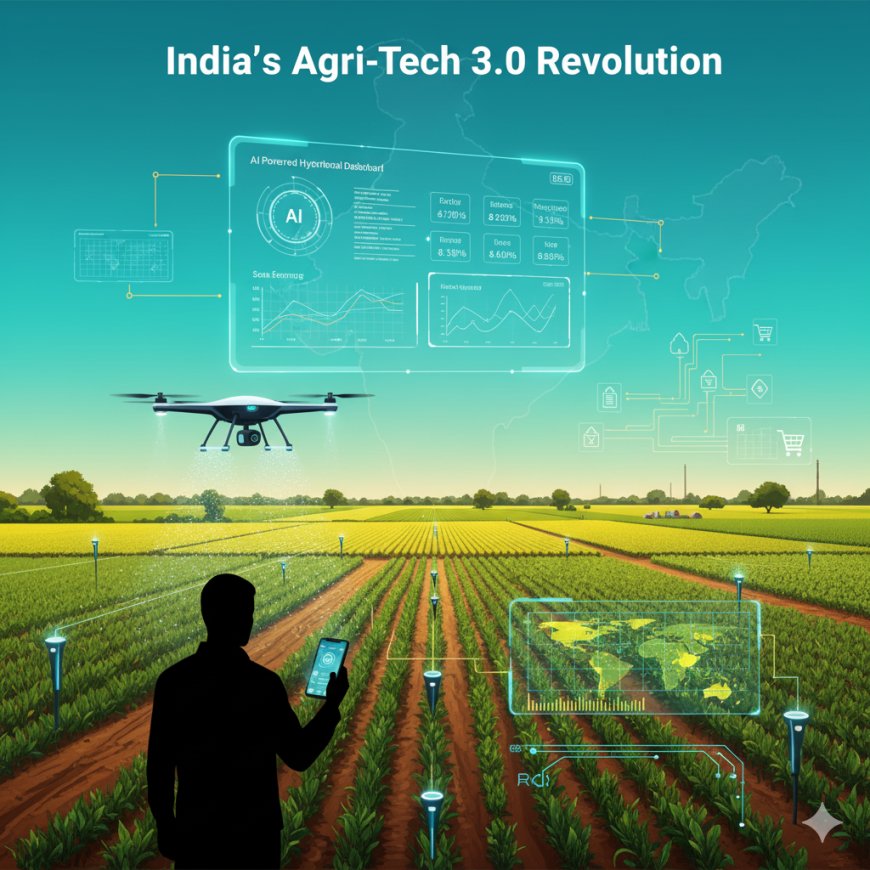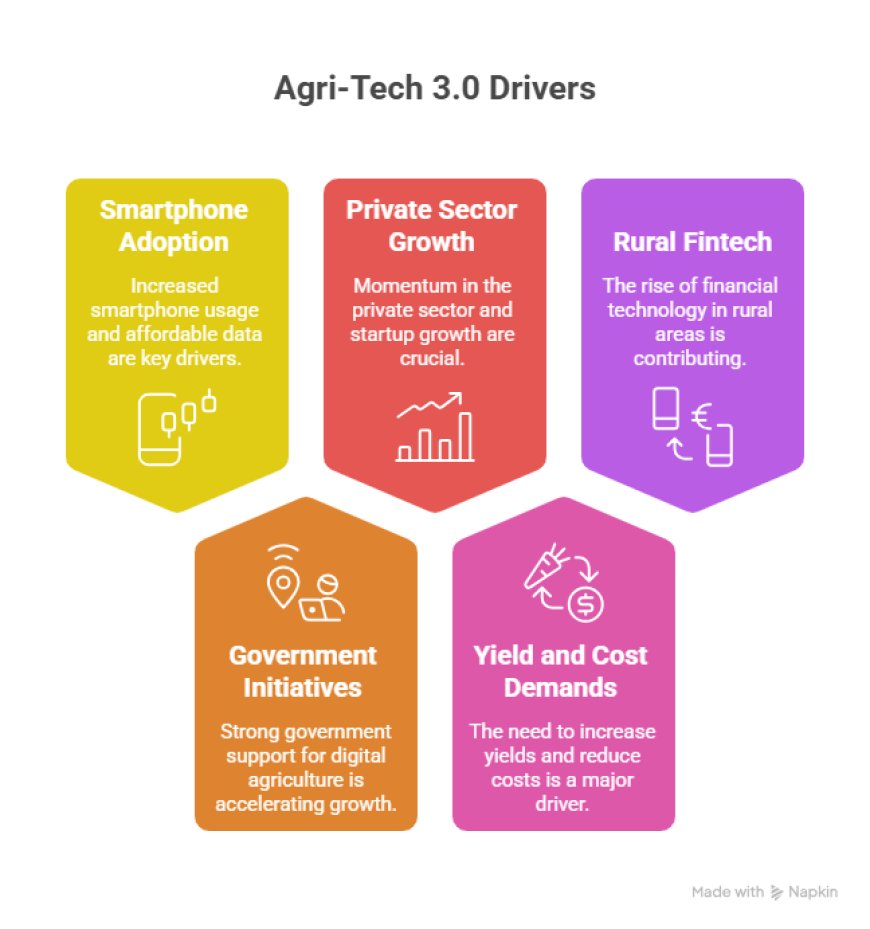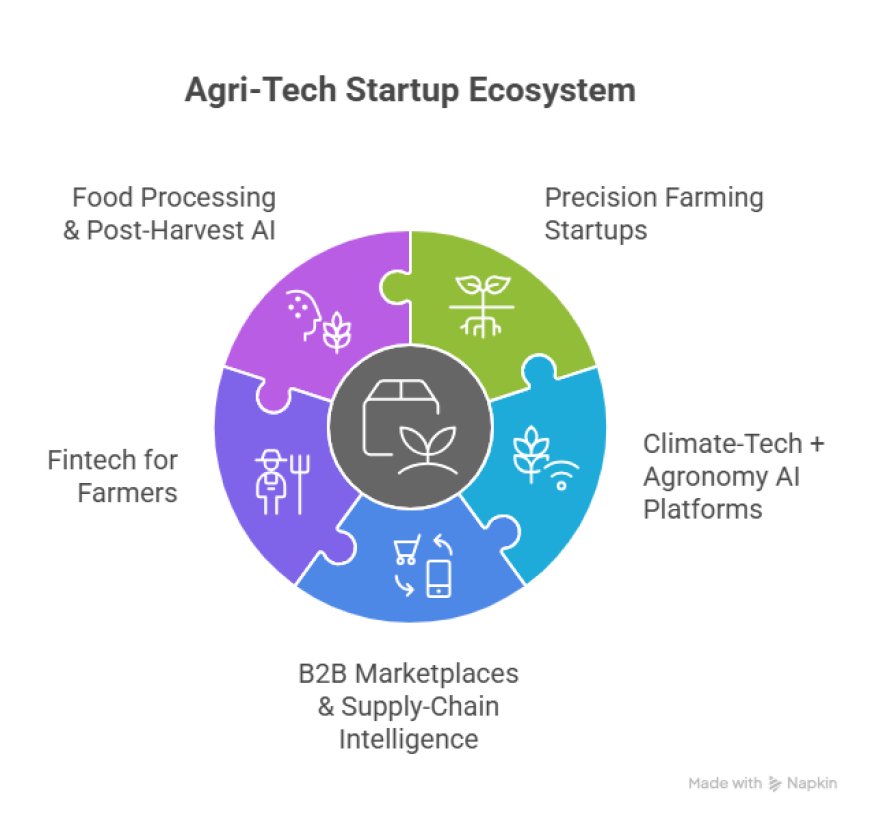India’s AI in Agriculture (Agri-Tech 3.0)
India’s Agri-Tech 3.0 revolution is transforming farming with AI weather models, soil sensors, drones, and digital marketplaces—boosting yields and rural incomes.

For decades, Indian agriculture has been the backbone of the economy, feeding 1.4 billion people and sustaining millions of rural households. Yet, despite its massive scale, productivity challenges continue to hold the sector back — unpredictable monsoons, soil degradation, pest attacks, price fluctuations, and inefficient supply chains.
But a new wave of innovation is rewriting the story.
Agri-Tech 3.0 — powered by AI, IoT sensors, satellite data, drones, and mobile-first platforms — is transforming how farmers make decisions. What was once guided by “experience and intuition” is now increasingly driven by data, predictive insights, and on-ground intelligence.
Surprisingly, this transformation isn’t being led by cities alone.
Rural India is digitizing faster than many urban regions, with smartphone penetration skyrocketing, UPI payments becoming ubiquitous, and local entrepreneurs adopting tech solutions rapidly.
As tools like hyperlocal weather predictions, AI-based soil testing, drone spraying, and digital marketplaces reach village-level entrepreneurs and FPOs, India is shifting from traditional farming → to precision agriculture at national scale.
This is the moment where technology, climate resilience, and grassroots adoption converge — and it is redefining the future of Indian agriculture.
The Drivers Accelerating Agri-Tech 3.0
India’s AI-driven agriculture revolution isn’t accidental — it is the result of several powerful forces coming together at the same time.
1. Smartphone Explosion + Cheap Data
India’s villages have experienced a mobility and connectivity leap.
Farmers today check:
- weather forecasts
- mandi prices
- government schemes
- video tutorials
- digital advisory
—all through low-cost smartphones and fast 4G/5G networks.
This digital baseline is what makes advanced tools like AI crop alerts or IoT sensors usable at scale.
2. Strong Government Push Toward Digital Agriculture
The government is actively accelerating Agri-Tech 3.0 through major initiatives:
- Digital Agri Mission — creating unified farmer databases and digital advisory systems
- Drone subsidies & liberalized rules — enabling drone spraying at village level
- eNAM — connecting mandis across India for transparent pricing
- PM-Kisan & public digital infrastructure — enabling digital payments and benefits
Policy tailwinds are making tech-friendly farming the norm, not the exception.

3. Private-Sector Momentum & Startup Growth
India now hosts 1,500+ agritech startups, many backed by climate-tech and deep-tech investors.
Venture capital interest is rising in:
- AI weather forecasting
- soil intelligence platforms
- agri-fintech tools
- drone-as-a-service
- supply chain digitization
FPOs, startups, equipment manufacturers, and marketplaces are creating an ecosystem where innovation spreads quickly.
4. Demand to Boost Yield & Cut Costs
With rising fertilizer costs, unpredictable rainfall, and crop losses, farmers are under pressure.
This has increased the demand for:
- precision irrigation
- pest and disease prediction
- soil health monitoring
- yield-boosting AI advisories
Technology is no longer optional — it is a necessity.
5. Rise of Rural Fintech
Farmers now use digital tools for:
- equipment loans
- micro-credit
- insurance
- payments
- input purchases
This financial inclusion enables them to afford sensors, drones, micro-irrigation systems, and marketplace subscriptions.
Together, these drivers are pushing India toward the most significant agricultural transformation in its history — powered by AI, automation, and data.
AI Weather Modeling: Predicting Monsoons, Managing Risk
For decades, Indian farmers relied on broad regional forecasts that often failed to capture the realities of microclimates. A 50 km error in predicted rainfall could mean the difference between a successful harvest and a major loss.

AI weather modeling is changing that.
Today’s climate intelligence tools deliver hyperlocal forecasts — accurate down to a single farm or village. These insights help farmers plan with far more confidence.
What AI Weather Models Can Predict
- Rainfall patterns: When to sow, irrigate, or harvest
- Humidity & wind movement: Critical for spraying cycles
- Pest & disease outbreaks: Based on climate triggers
- Heatwaves & cold spells: Enabling crop protection measures
- Flood or drought risk: Helping with crop insurance and contingency plans
Machine learning models combine satellite data, on-ground sensors, and historical weather patterns to generate precise, actionable insights.
Startups Leading the Shift
A new class of Indian and global climate-intelligence startups are building tools tailored for India’s unique climatic variability. These platforms integrate:
- Real-time satellite imagery
- AI crop stress detection
- Microclimate forecasting
- Pest prediction algorithms
Farmers receive alerts and recommendations directly on their phones, sometimes in regional languages.
Benefits to the Farming Ecosystem
- Reduced crop loss: By responding to climate signals before damage occurs
- Optimized sowing windows: Ensuring seeds go into soil at the ideal time
- Lower costs: Avoiding unnecessary fertilizer or spray use
- Stronger insurance claims: With digital climate records as evidence
AI weather modeling is not just a tool — it’s becoming the backbone of climate-resilient agriculture in India.
Soil Sensors & Smart Irrigation: The Underground Revolution
Beneath the soil lies the invisible heartbeat of Indian agriculture — moisture, nutrients, temperature, and microbial life. Yet, for generations, farmers judged soil health by feel and experience alone.
Today, a revolution is happening underground.
IoT Sensors Bringing the Soil to Life
Affordable IoT devices placed in fields now measure:
- Moisture levels
- Soil temperature
- Nutrient composition (NPK)
- Electrical conductivity (health indicator)
These readings are uploaded to cloud platforms where AI models analyze soil health 24/7.
Smart Irrigation Systems
Smart irrigation pumps powered by AI and IoT allow farmers to:
- Turn pumps on/off remotely using mobile apps
- Automate irrigation based on soil moisture thresholds
- Reduce wasteful overwatering
- Improve crop root health
This results in precision irrigation, ensuring every drop of water is used efficiently.
AI-Driven Fertilizer Management
Based on sensor data, AI can recommend:
- The right nutrient mix
- The right quantity
- The right time to apply
This reduces input costs significantly and prevents nutrient burn or soil damage.
Impact on Farmers and the Environment
- Lower water consumption — essential in states with groundwater stress
- Healthier, more resilient crops
- Reduced electricity usage for pumping
- Better soil conservation
- Higher yields at lower input cost
In many regions, soil sensors and smart irrigation systems are proving to be more transformative than any new seed variety or fertilizer.
Drone Spraying & Aerial Intelligence: Farm Operations Redefined
Just a few years ago, farm drones felt like science fiction in India. Today, they are becoming one of the fastest-adopted innovations in rural areas — thanks to lower costs, supportive policies, and growing awareness.
Drones are now redefining how Indian farms are monitored, sprayed, and managed.
The New Role of Drones in Indian Farming
Modern agricultural drones are capable of:
- Precision pesticide & fertilizer spraying
- Uniform nutrient application across large fields
- Seed broadcasting in specific terrains
- Multispectral and thermal imaging for crop analysis
- Mapping fields to identify irrigation gaps or crop stress
This aerial approach is faster, safer, and more accurate than manual spraying, reducing farmers’ exposure to chemicals.
Aerial Intelligence for Better Decision-Making
Using AI models, drone-captured imagery can detect:
- Early pest infestations
- Water stress zones
- Nutrient deficiencies
- Weed outbreaks
- Yield variation patterns
This helps farmers act before problems escalate — improving yields while cutting unnecessary input costs.
The Rise of Drone-as-a-Service (DaaS)
Instead of buying expensive equipment, farmers now subscribe to DaaS (Drone-as-a-Service) models, where local operators provide:
- On-demand spraying
- Imaging surveys
- Field mapping
- Crop health reports
These services have brought cutting-edge technology to even smallholder farmers.
Government Push → Faster Adoption
India’s regulatory environment is accelerating the shift:
- Drone Rules 2021 simplified permissions
- Subsidies for drone purchases for FPOs
- Kisan Drone initiatives promoting village-level entrepreneurship
The result: drones are becoming a mainstream tool in Indian agriculture, unlocking a new era of aerial precision farming.
Farmer Marketplaces & Supply Chain AI
Beyond the farm, India’s agriculture system faces challenges of fragmented markets, information asymmetry, and middlemen-driven inefficiencies. Digital platforms and AI-powered supply chains are fixing these structural gaps.
Digital Marketplaces: Connecting Farmers to the Right Buyers
Modern agritech marketplaces now enable farmers to:
- Sell produce directly to buyers, retailers, processors, and exporters
- Access transparent pricing
- Avoid exploitative intermediaries
- Get paid faster via UPI and digital wallets
These platforms act as a bridge between farms and markets — creating fairer, more reliable trade.
AI Scoring & Pricing Prediction
AI systems help farmers understand:
- Crop quality and grading using image recognition
- Expected pricing trends based on demand and seasonality
- Optimal selling time for maximum realization
- Best-fit buyers according to quality and volume
This reduces uncertainty and increases farmers' income stability.
Real-Time Visibility Across the Value Chain
Platforms now provide live updates on:
- Daily mandi prices
- Weather shocks affecting supply
- Local input shortages
- Logistics availability
- Demand patterns from food processors and retailers
This information was once scattered, unreliable, or delayed — now it’s accessible instantly on a smartphone.
FPO Integration & Smarter Logistics
Farmer Producer Organizations (FPOs) are being digitally integrated to:
- Aggregate produce
- Negotiate better prices
- Coordinate transportation
- Reduce wastage through improved post-harvest management
AI-driven logistics planning ensures faster, lower-cost delivery and reduced crop spoilage.
Outcome: A More Efficient, Transparent Agricultural Ecosystem
With AI and digital marketplaces:
- Farmers earn more
- Supply chains become predictable
- Waste is reduced
- Prices stabilize
- Buyers get consistent quality
In short: technology is creating a more equitable and efficient agricultural economy in India.
The Emerging Agri-Tech Startup Landscape
India’s Agri-Tech ecosystem is entering its most transformative phase yet. A wave of startups is solving challenges spanning farm inputs, productivity, finance, and market linkages — building what many call Agri-Tech 3.0.
Below is a breakdown of the most active innovation categories:

Precision Farming Startups: Sensors, Robotics & Drones
Startups are building tools that help farmers make data-based decisions instead of guesswork.
Key solutions include:
- IoT soil sensors measuring moisture, nutrients, pH, and temperature
- Climate and irrigation controllers for precision watering
- Autonomous robots for sowing, weeding, spraying, harvesting
- Agri drones offering aerial spraying, imaging, and real-time crop health data
These tools improve yields, reduce chemical use, and cut operating costs — especially valuable for water-stressed or pest-prone regions.
Climate-Tech + Agronomy AI Platforms
With climate volatility rising, many startups are focused on hyperlocal intelligence to help farmers manage risks.
Their offerings include:
- AI-led weather predictions and monsoon forecasting
- Pest and disease prediction using satellite + ground data
- Crop advisory based on soil, weather, and historical patterns
- Recommendation engines for fertilizers, planting dates, and irrigation
These platforms act as a digital agronomist, available 24/7, at a fraction of the traditional cost.
B2B Marketplaces & Supply-Chain Intelligence
India’s fragmented supply chain is ripe for digital disruption — and startups are addressing it with tech-first solutions.
They enable:
- Input marketplaces (seeds, fertilizers, equipment, sensors)
- Output marketplaces (farm-to-retail, farm-to-factory, export channels)
- Inventory aggregation through FPOs
- AI-driven demand and price prediction
- Smart logistics planning to reduce spoilage
The result: fairer prices for farmers, lower wastage, and more predictable supply for buyers.
Fintech for Farmers: Credit Scoring & AI-led Crop Insurance
Rural India is massively underserved in credit — and technology is closing the gap.
Fintech innovators are building:
- AI credit scoring using farm data, satellite imagery, land records
- Digital KYC + UPI-based payouts
- Crop insurance underwriting using weather and yield models
- Buy-now-pay-later models for seeds, fertilizers, and drones
This reduces the dependence on informal lenders and gives farmers access to timely, affordable capital.
Food Processing & Post-Harvest AI
The post-harvest supply chain is one of India’s biggest sources of waste — up to 30% in some crops. AI is solving this through smarter grading and handling.
Startups are enabling:
- Computer-vision grading of fruits, vegetables, grains
- Automated sorting and packaging systems
- Smart cold-chain monitoring
- AI quality scoring for export standards
Better post-harvest systems increase farmer income and give India a competitive edge in global supply chains.
Challenges India Must Overcome
Even as Agri-Tech evolves rapidly, there are real barriers that must be addressed for mass adoption. Modern agriculture solutions must be affordable, accessible, and easy to use — especially for small and marginal farmers who form the majority of India’s rural economy.
Here are the key challenges:
Affordability Gaps for Small & Marginal Farmers
- Many tech solutions — drones, sensors, automated graders — are still expensive.
- Farmers with small landholdings cannot justify high CapEx tools.
- Need for shared models like DaaS (Drone-as-a-Service), rental kiosks, and cooperatives.
Connectivity Issues in Deep Rural Pockets
- Patchy internet limits the use of AI apps, cloud-based advisory, and mobile dashboards.
- IoT devices struggle in low-signal regions.
- Offline-first solutions are essential for nationwide adoption.
Need for On-Ground Training & Agronomy Advisory
- Many farmers need help understanding how to use sensors, apps, drones, and digital marketplaces.
- Without education and support, adoption remains slow.
- Scalable models through FPOs, Krishi Vigyan Kendras, and private field officers are crucial.
Data Privacy & Fragmented Data Standards
- Farm, soil, and land data is sensitive and often stored across multiple, non-integrated systems.
- Lack of unified standards slows platform interoperability.
- Clear guidelines are needed for responsible use of agricultural data.
Scaling Hardware in Price-Sensitive Markets
- Hardware manufacturing (drones, sensors, robotics) faces challenges in cost, durability, and maintenance.
- Many systems need imports for components, increasing prices.
- India requires stronger local manufacturing and repair ecosystems.
The Opportunity: India as a Global Agri-Tech Export Power
India is not just adopting AI in agriculture — it is quietly building the world’s most scalable blueprint for digital farming. With 140+ million hectares of farmland, ultra-diverse crops, and highly variable climatic zones, India offers the perfect “stress test” for agri-tech innovation. What works here can work almost anywhere.
Why India is positioned to lead globally:
· Massive scale that generates rich agricultural datasets — ideal for training robust AI models.
· Startup momentum creating solutions that are affordable, modular, and built for smallholder farmers — a model relevant across Asia, Africa, and Latin America.
· Government push for drones, soil digitization, and marketplaces, providing a strong regulatory foundation.
Potential export engines include:
· AI Models:
o Climate prediction, soil intelligence, disease detection, yield forecasting.
o Adaptive algorithms built for low-resource environments — highly in demand globally.
· Drone Technology:
o Spray drones, imaging drones, and drone-as-a-service (DaaS) business models.
o Indian drones are becoming cost-competitive alternatives to global manufacturers.
· Farmer-Marketplace Platforms:
o Digital mandi systems.
o Quality grading and price prediction engines.
o Integrated supply-chain visibility platforms.
The bigger impact:
· Transform rural incomes by bringing global demand directly to Indian farm-gate systems.
· Boost national food security with climate-resilient, tech-enabled farming.
· Reduce climate risk by using predictive models to guide farming cycles.
Global agriculture giants — from input companies to food processors — are increasingly partnering with Indian agri-tech firms to deploy these innovations across emerging markets. India’s agri-tech IP is becoming an exportable competitive advantage.
Conclusion
India’s agricultural transformation has begun — quietly, rapidly, and digitally.
The next decade will see Indian farms equipped with intelligent tools, data-powered decisions, and AI systems that guide everything from sowing to selling. Agri-Tech 3.0 is not about replacing farmers; it is about empowering them with insights that were once unimaginable.
The future of Indian farming will be:
· Digital: Powered by sensors, AI models, drone intelligence, and mobile-first ecosystems.
· Connected: Linking farms to markets, weather systems to irrigation pumps, and buyers to FPOs in real time.
· AI-driven: Turning every data point — soil moisture, disease alerts, market demand — into actionable recommendations.
Rural India, often underestimated, is emerging as a surprising tech powerhouse, adopting digital tools at a speed that outpaces many urban markets. This shift signals a new growth wave where agriculture becomes both profitable and climate-resilient.
Agri-Tech 3.0 can reshape:
· Farmer incomes through efficiency and market access.
· Sustainability by optimizing water, fertilizer, and pesticide usage.
· National food resilience with predictive climate and crop intelligence.
India is not merely adapting to the future of agriculture —
India is building it.
What's Your Reaction?
 Like
0
Like
0
 Dislike
0
Dislike
0
 Love
0
Love
0
 Funny
0
Funny
0
 Angry
0
Angry
0
 Sad
0
Sad
0
 Wow
0
Wow
0
























































































































































































